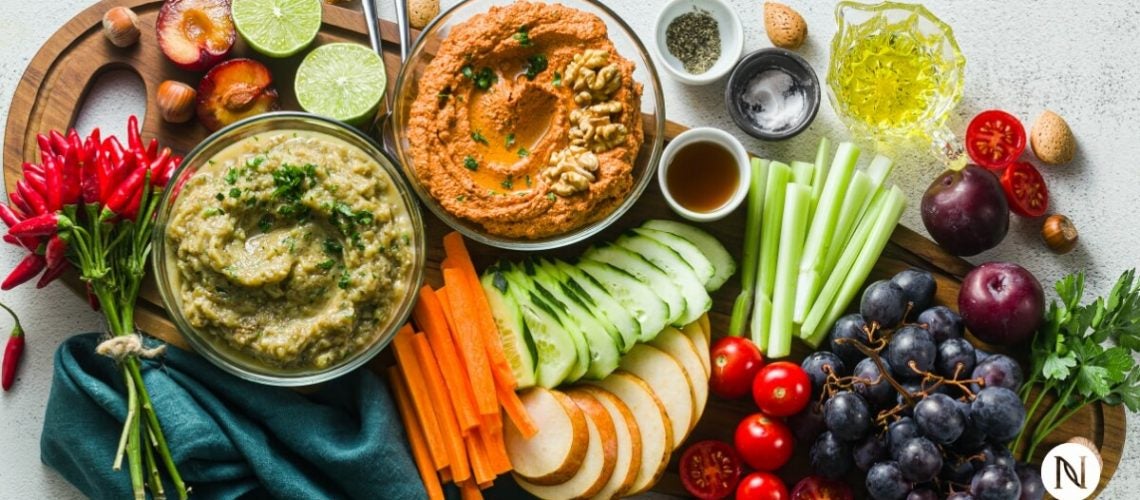Tip Sheet: 5 Ways to Get More Veggies In

Besides protein, veggies are one of the best go-tos to keep in your weight loss toolbox to boost your weight loss success. When it comes to losing weight, eating more veggies is a game changer. Incredibly nutrient-dense – meaning they have a high level of key nutrients like vitamins, minerals, fiber, and water – and low in calorie density, veggies can truly transform your health. The USDA Dietary Guidelines recommend at least 2-3 cups per day for adult women, but I encourage increasing this even more to maximize weight loss. Here are five ways to get more of those healthy veggies in your diet.
1. Make Cauliflower your BFF
If you tuned in to my Facebook Live last month, you know that I am a big fan of cauliflower. This mild-tasting cruciferous veggie takes on the flavors of anything you cook it with. When “riced”, cauliflower can be seamlessly incorporated into smoothies or oatmeal to add volume, fiber and nutrients. And of course, if you haven’t heard by now, cauli can be made into low carb pizza crust (just Google Cauliflower Pizza Crust for recipes!).
My favorite way to use cauliflower is to simply swap it out for rice. While a cup of rice has about 200 calories, a cup of cauliflower rice has only 25, and is full of fiber and nutrients like vitamin C and magnesium. Replacing rice in your staple recipes at home with cauliflower rice can help make weight loss a breeze without compromising taste or satisfaction.
2. When in Doubt, Spiralize It
If you don’t have a spiralizer yet, it’s time to get on board! Spiralizers retail for as low as $10, and they can help easily get those veggies in every day. A spiralizer transforms vegetables such as zucchini, carrots, beets, and sweet potato into low-calorie, low-carb veggie noodles. Spiralized veggies are the ultimate “weight loss pasta” to help take your nutrition up a notch.
Serve your favorite turkey Bolognese sauce over spiralized zucchini noodles for a protein- and fiber-packed meal that will keep you satisfied for a fraction of the calories of a traditional Spaghetti Bolognese.
3. Do Dip It
The latest research – and our tastebuds – deem that having a delicious dip on hand is one sure way to make veggie snacking more appealing. Since dips can often be high in calories, fat and added sugar, it’s important to seek out healthy options and be mindful of portions.
Dieticians recommend both guacamole and hummus as choice options. Can’t live without ranch? Whip up your own lower fat version using plain nonfat Greek yogurt as the base instead of mayonnaise.
4. Reorganize your Fridge
Eating more vegetables can really be as easy as changing where you store them in the fridge. Placing sliced veggies in the middle shelf at eye level puts them in plain sight and makes you more likely to grab them when you are hankering for a snack.
Make Sunday your meal-prep day. Slice up veggies like cucumber “chips,” sliced carrots and celery, cherry tomatoes, and sugar snap peas for easy snacking.
5. Get Sneaky
You don’t need to completely overhaul your diet to get in your daily 2-3 cup servings of veg. There are a lot of ways to “sneak” veggies into your favorite meals that you’re already eating.
- Puree pumpkin or squash into your pancake or waffle mix
- Add a handful of spinach to your fruit smoothie
- Add riced cauliflower to oatmeal or scrambled eggs
- Replace half the meat in your homemade burger or Bolognese recipe with minced mushrooms
- Puree pumpkin, carrots, or spinach into marinara sauce
- Bake mild-tasting grated zucchini into baked goods like muffins and brownies
By now you can see that there are so many ways to add more vegetables to your daily eats. Some can be snuck right into recipes, while others can be prepared in unique ways to make them more palatable. Adding more veggies to your life will not only boost your overall nutrition but make weight loss a lot easier. So get going and give one of these ‘sneaks’ a try this week!
No Comments